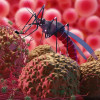.png)
Emerging Infectious Diseases: Chandipura Virus symptoms and treatment
Emerging infectious
diseases pose a significant threat to global health, and the Chandipura virus
(CHPV) is one such pathogen that has garnered attention in recent years. This
article delves into the symptoms and treatment of CHPV, providing a
comprehensive overview based on current research.
Chandipura virus: An insight
Chandipura virus is
named after the town of Chandipura in Maharashtra, India, where it was first
isolated in 1965. The virus belongs to the Rhabdoviridae family. It is
primarily transmitted through sandflies (Phlebotomus species) and has been
responsible for several outbreaks in India, posing a severe public health
concern, especially among children.1,2The 2003-2004 Chandipura virus outbreaks
in Central India showed higher death rate, ranging from 56-75% in Andhra
Pradesh and Gujarat exhibiting encephalitic symptoms.3
Chandipura Virus Symptoms
The clinical
presentation of CHPV infection can be rapid and severe. The incubation period
ranges from 2 to 10 days, after which the following symptoms may manifest:
- Fever: High-grade fever is often one of the
earliest symptoms.
- Neurological Symptoms: Patients can develop encephalitic symptoms,
including seizures, altered mental status, and coma. These neurological
manifestations, such as abnormal reflexes of toes and deep tendons,
abnormalities associated with a pupil of the eye, and abnormalities related
to the tone of the muscles, are particularly concerning as they can lead
to rapid deterioration.
- Gastrointestinal Symptoms: Vomiting may also be present.
- Skin Lesions: Rashes with swelling and fluid can also be
seen in some cases, which later get hyperpigmented upon healing.4,5
Chandipura Virus Diagnosis
Early diagnosis of
CHPV is crucial for effective management. Laboratory confirmation is typically
achieved through:
- RT-PCR: Detection of viral RNA using reverse
transcription-polymerase chain reaction (RT-PCR) is the gold standard.
- Serology: Enzyme-linked immunosorbent assay (ELISA)
can detect specific antibodies against CHPV.
- Virus Isolation: Though less common due to its complexity,
virus isolation in cell cultures remains a definitive diagnostic method.
Techniques like the immunofluorescent antibody technique were
performed to detect the presence of CHPVin brain tissues during the 2003
outbreak.3,6
Chandipura Virus Treatment
Currently, there is
no specific antiviral treatment for CHPV. Management is primarily supportive
and symptomatic, focusing on the following aspects:
- Fever and Pain Management: Antipyretics like acetaminophen can be used
to manage fever and pain.
- Hydration: Intravenous fluids may be necessary to
prevent dehydration, especially in patients with severe vomiting.
- Seizure Control: Anticonvulsants are administered to control
seizures.
- Intensive Care: Patients with severe neurological symptoms
often need intensive care for close monitoring and management of
complications.
- Antiviral treatment: Antiviral medications for CHPV are still
being researched. Although broad-spectrum antiviral ribavirin has
demonstrated some efficacy in lab tests, its clinical use for treating
CHPV is still debatable.
- Immunotherapy: Preclinical research on passive
immunotherapy, which involves the administration of neutralizing
antibodies, has shown encouraging results in managing CHPV infections. A
few research studies have established that monoclonal antibodies can
target CHPV glycoprotein, which, in turn, can neutralize the virus and
stop its transmission.
- Vaccines: Although no vaccine has been approved yet,
various investigations are underway to develop a vaccine against the
virus. Several vaccination approaches are being investigated currently,
including recombinant viral proteins, inactivated vaccines, and live-attenuated
vaccines. Ensuring both efficacy and safety, particularly in young
children, is one of the problems in vaccine development.4,5,7
Chandipura Virus Prevention
Preventing CHPV
infection hinges on reducing exposure to sandfly bites. This can be achieved
through:
- Insect Repellents: Use of insect repellents on exposed skin.
- Protective Clothing: Wearing long-sleeved shirts and pants to
minimize skin exposure.
- Insecticide-Treated Nets: Utilizing bed nets treated with
insecticides, especially in endemic regions.
- Environmental Control: Reducing sandfly breeding sites by managing
waste and maintaining clean surroundings.7,8
However,
maintaining sanitary conditions has become a challenge in areas with ongoing
construction, as the sandflies breed in damp places inside crevices of stone
used for construction where insecticide spraying is usually not feasible.
Another practice of the people living in the endemic areas is smearing cow dung
on the walls and floors of their homes and storing dried sheets of cow dung
within their homes as feed, which acts as a breeding and resting ground for
sandfly larvae; thus, warranting the need of awareness among dwellers.3
DISEASE
PREPAREDNESS IN INDIA
The Ministry of
Health and Family Welfare, Govt of India, has taken the following prevention
and control measures:
- Deployment of National Joint Outbreak
Response Team (NJORT): A specialized team has been sent to help the state government of
Gujarat carry out comprehensive epidemiological investigations and public
health measures.
- Health and awareness campaigns: There are programs in place to educate the
public and medical professionals about the virus, its symptoms, and how to
avoid it.
- Research and monitoring: The Gujarat Biotechnology Research Centre
(GBRC) is carefully monitoring the issue and is aggressively identifying
more viruses that cause encephalitis.
- Vector control measures: Comprehensive fumigation and insecticidal
spraying are being done to manage the virus's vectors, i.e., sandflies.
- Advisories and coordination: Joint advisories from the National Centre
for Disease Control (NCDC) and the National Centre for Vector Borne
Diseases Control (NCVBDC) are being issued to guide neighboring states in
reporting cases of encephalitis.7
Conclusion
Chandipura virus
remains a critical public health challenge due to its potential for rapid
spread and severe neurological impact. While no specific antiviral treatment is
available, supportive care can significantly improve patient outcomes.
Prevention strategies focusing on reducing sandfly exposure are essential in
mitigating the risk of infection. Ongoing research and surveillance are vital
to understand better and combat this emerging infectious disease.








Please login to comment on this article